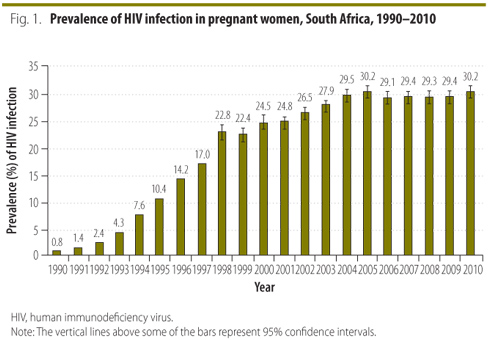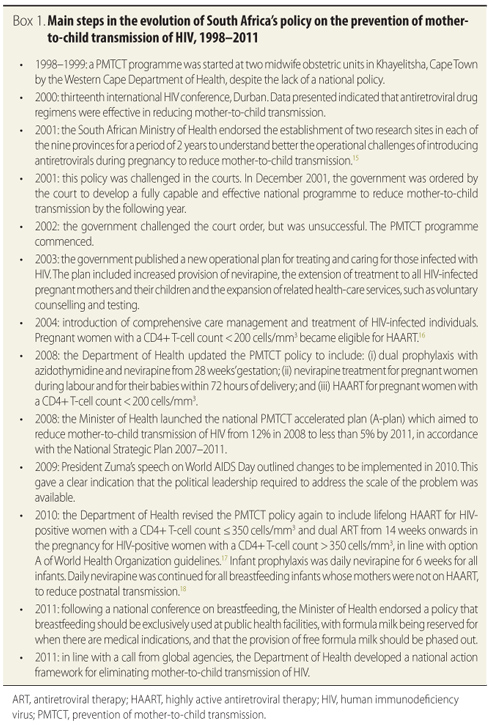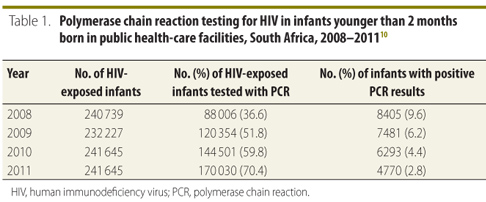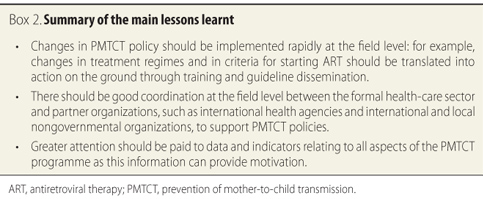LESSONS FROM THE FIELD
Eliminating mother-to-child HIV transmission in South Africa
Élimination de la transmission du VIH de la mère à l'enfant en Afrique du Sud
Cómo eliminar la transmisión del VIH de la madre al niño en Sudáfrica
Peter BarronI,*; Yogan PillayII; Tanya DohertyIII; Gayle ShermanIV; Debra JacksonV; Sanjana BhardwajVI; Precious RobinsonII; Ameena GogaIII
ISchool of Public Health, Faculty of Health Sciences, University of the Witwatersrand, York Road, Johannesburg, Gauteng, 2193, South Africa
IIDepartment of Health, Pretoria, South Africa
IIIHealth Systems Research Unit, Medical Research Council, Cape Town, South Africa
IVDepartment of Molecular Medicine and Haematology, University of the Witwatersrand, Johannesburg, South Africa
VSchool of Public Health, University of the Western Cape, Cape Town, South Africa
VIUnited Nations Children's Fund, Pretoria, South Africa
ABSTRACT
PROBLEM: The World Health Organization has produced clear guidelines for the prevention of mother-to-child transmission (PMTCT) of the human immunodeficiency virus (HIV). However, ensuring that all PMTCT programme components are implemented to a high quality in all facilities presents challenges.
APPROACH: Although South Africa initiated its PMTCT programme in 2002, later than most other countries, political support has increased since 2008. Operational research has received more attention and objective data have been used more effectively.
LOCAL SETTING: In 2010, around 30% of all pregnant women in South Africa were HIV-positive and half of all deaths in children younger than 5 years were associated with the virus.
RELEVANT CHANGES: Between 2008 and 2011, the estimated proportion of HIV-exposed infants younger than 2 months who underwent routine polymerase chain reaction (PCR) tests to detect early HIV transmission increased from 36.6% to 70.4%. The estimated HIV transmission rate decreased from 9.6% to 2.8%. Population-based surveys in 2010 and 2011 reported transmission rates of 3.5% and 2.7%, respectively.
LESSONS LEARNT: Critical actions for improving programme outcomes included: ensuring rapid implementation of changes in PMTCT policy at the field level through training and guideline dissemination; ensuring good coordination with technical partners, such as international health agencies and international and local nongovernmental organizations; and making use of data and indicators on all aspects of the PMTCT programme. Enabling health-care staff at primary care facilities to initiate antiretroviral therapy and expanding laboratory services for measuring CD4+ T-cell counts and for PCR testing were also helpful.


RÉSUMÉ
PROBLÈME: L'Organisation mondiale de la Santé a élaboré des lignes directrices claires pour la prévention de la transmission mère-enfant (PTME) du virus de l'immunodéficience humaine (VIH). S'assurer que tous les éléments du programme de PTME soient mis en uvre de manière qualitative dans tous les établissements présente cependant des défis.
APPROCHE: Bien que l'Afrique du Sud ait lancé son programme de PTME en 2002, plus tard que la plupart des autres pays, le soutien politique a augmenté depuis 2008. La recherche opérationnelle a reçu davantage d'attention, et les données objectives ont été utilisées plus efficacement.
ENVIRONNEMENT LOCAL: En 2010, environ 30% de toutes les femmes enceintes en Afrique du Sud étaient séropositives, et la moitié de tous les décès dénfants de moins de 5 ans étaient associée au virus.
CHANGEMENTS SIGNIFICATIFS: Entre 2008 et 2011, la proportion estimée de nourrissons de moins de 2 mois exposés au VIH, ayant subi une réaction en chaîne par polymérase (PCR) de routine visant à détecter la transmission précoce du VIH, est passée de 36,6% à 70,4%. Le taux estimé de transmission du VIH a diminué, passant de 9,6% à 2,8%. Les enquêtes basées sur la population en 2010 et 2011 ont signalé des taux de transmission de 3,5% et 2,7%, respectivement.
LEÇONS TIRÉES: Voici certaines actions essentielles pour améliorer les résultats du programme: assurer la mise en uvre rapide des changements de politique de PTME sur le terrain, grâce à la formation et à la diffusion des lignes directrices; assurer une bonne coordination avec les partenaires techniques, comme les agences de santé internationales et locales et les organisations non gouvernementales; et utiliser les données et les indicateurs relatifs à tous les aspects du programme de PTME. Il est aussi utile de permettre au personnel soignant des établissements de soins de santé primaires d'initier un traitement antirétroviral et de développer les services de laboratoire pour les décomptes de cellules CD4 + T et les tests PCR.

RESUMEN
SITUACIÓN: La Organización Mundial de la Salud ha presentado unas directrices claras para la prevención de la transmisión del virus de la inmunodeficiencia humana (VIH) de la madre al niño. No obstante, habrá que superar algunos desafios para asegurar la puesta en marcha de todos los elementos del programa de prevención a fin de alcanzar un nivel de calidad elevado en todas las instalaciones.
ENFOQUE: Aunque Sudáfrica inició su programa de prevención en el ano 2002, más tarde que la mayoria de los paises, el apoyo politico ha aumentado desde 2008. Se ha prestado más atención a las investigaciones operativas y los datos objetivos se han utilizado con mayor eficacia.
MARCO REGIONAL: En 2010, alrededor del 30% de las mujeres embarazadas en Sudáfrica eran seropositivas, y la mitad de todas las muertes en niños menores de cinco anos estuvieron asociadas al virus.
CAMBIOS IMPORTANTES: Entre los anos 2008 y 2011, la proporción estimada de niños menores de dos meses expuestos al VIH que se sometió a las pruebas rutinarias de reacción en cadena de la polimerasa aumentó del 36,6% al 70,4%, y la tasa estimada de transmisión del VIH se redujo del 9,6% al 2,8%. Las encuestas de población de los anos 2010 y 2011 reflejaron unas tasas de transmisión del 3,5% y el 2,7%, respectivamente
LECCIONES APRENDIDAS: Las actividades fundamentales para mejorar los resultados del programa incluyeron: garantizar la implementación rápida de los cambios en la política de prevención de la transmisión a nivel de campo mediante cursos formativos y la difusión de las directrices; garantizar una coordinación adecuada entre los socios técnicos, tales como las agencias sanitarias internacionales y las ONG locales e internacionales; y utilizar los datos e indicadores acerca de todos los aspectos del programa de prevención de la transmisión del VIH de la madre al niño. También resultó muy útil permitir al personal sanitario de los centros de atención primaria iniciar terapias antirretrovirales y ampliar los servicios de laboratorio para realizar los recuentos de linfocitos T CD4+ y las pruebas de reacción en cadena de la polimerasa.
Introduction
The magnitude of the problem of human immunodeficiency virus (HIV) infection in South Africa is illustrated in Fig. 1, which shows the rise of the HIV pandemic since 1990 and its stabilization after 2004. In 2010, 30.2% of all pregnant women who attended public sector health-care facilities were infected.1 The prevalence of HIV infection among pregnant women is likely to remain high for at least the next two decades because the number of people receiving life-long antiretroviral therapy (ART) in South Africa is still increasing and is predicted to plateau at around 3 million in 2016.2

In 2011, an estimated 70.4% of maternal deaths in South Africa were associated with HIV infection,3 as were half of all deaths of children younger than 5 years.4 Consequently, the success of programmes for the prevention of mother-to-child transmission (PMTCT) of HIV is critical for reducing maternal and child mortality and morbidity.
Evolution of the PMTCT programme
Although the burden of HIV infection in South Africa had been large for many years, the country did not implement a PMTCT programme until 2002. The main steps in the evolution of South Africa's PMTCT policy are listed in Box 1.

In tandem with changes in policy, continuous efforts were also being made to improve the quality of the programme using operational research. A review of the initial 18 pilot sites for the PMTCT programme led to several recommendations for improving health-care systems, including that the programme be scaled up to all facilities.5 It was also recommended that: training of front-line workers be improved; all health-care workers be given more support and supervision; managers' commitment to the programme be increased; the PMTCT programme be integrated into existing primary health-care services, especially maternal services and services for women and children.
An evaluation of a quality improvement programme in one district in KwaZulu-Natal province showed that, although HIV testing during pregnancy had become routine and universal, coverage was less extensive for other elements of the PMTCT cascade,6 such as ensuring that HIV-positive mothers are treated and continue on treatment; testing infants exposed to HIV; and identifying and treating HIV-positive infants. It was recommended that these elements be given more attention and that programme data related to them be simplified and monitored regularly.7
Paying attention to data and indicators, such as the proportion of HIV-positive mothers receiving ART or prophylaxis, is critical for improving the quality, coverage and impact of the PMTCT programme. This was demonstrated further in a study in 2008 in three districts in KwaZulu-Natal where âa data quality improvement intervention that involved specific training for health-care workers on the importance of public health information, monthly data reviews and feedback, and regular data audits was effective in significantly increasing the completeness and accuracy of the data used to monitor PMTCT services in South Africaâ.8
In addition, a 2008 initiative in which data were used to improve quality of care in the programme focused attention on the health districts with the worst performance and strengthened implementation of the PMTCT cascade by sharing good practices.9
Between 2008 and 2011, major changes in professional practice occurred, including a shift towards nurses initiating and managing the use of ART. Nurses and midwives at primary care antenatal facilities were trained to provide ART for eligible pregnant women.
Results
In 2005, slightly fewer than 50% of all pregnant women were routinely tested for HIV infection. By 2009, testing was virtually universal. The maternal treatment regimen used for PMTCT has also changed over the past 10 years, from single-dose nevirapine to either dual therapy with nevirapine and azidothymidine from the 14th week of pregnancy onward or highly active antiretroviral therapy (HAART; Box 1) for women with a CD4+ T-cell count below 350 cells/mm3.
The testing of infants to identify HIV infection early has also increased. The results of routine tests in public health-care facilities are shown in Table 1. Between 2008 and 2011, the proportion of the estimated number of infants exposed to HIV who were tested before reaching the age of 2 months increased from 36.6% to 70.4%. Over the same period, the proportion of infants tested who were HIV-positive decreased from 9.6% to 2.8%.10

In 2010, the first national population-based survey of the effect of the South African PMTCT programme on early HIV transmission from mother to child reported an overall transmission rate of 3.5%. When the survey was repeated in 2011, the transmission rate was found to be 2.7%.11,12
The main lessons learnt during improvement of the PMTCT programme were: changes in national PMTCT policy should be implemented rapidly at all facilities; the efforts of partner organizations should be coordinated with those of the formal health-care sector; and data and indicators should be used to provide motivation (Box 2).

Challenges
Despite the remarkably successful implementation of the PMTCT programme in South Africa, many challenges remain. Some health districts have done better than others in ensuring that good quality data are collected routinely and that data are used by health workers and managers to continuously monitor and improve the programme. Moreover, there is also a need for mentoring and supportive supervisory systems that can help facilities use data effectively on a regular basis.7,13
In South Africa, pregnant women visit antenatal clinics at a relatively advanced stage of pregnancy; fewer than 40% of them attend for the first time before 20 weeks' gestation. Some pregnant women even go into labour without having attended an antenatal clinic once. The PMTCT policy introduced in 2010 (Box 1) requires HIV-positive pregnant women to attend an antenatal clinic early, at 14 weeks' gestation, so that interventions can be started as soon as possible. Increasing early attendance will require interventions at both the individual and community levels to raise demand for services. In addition, changes in attitudes towards health-care services and in their organization will be needed to boost supply.
Ensuring that all infants undergo early HIV testing is another important challenge, as is making sure that all those who test positive are referred for treatment. In addition, more attention should be given to testing infants exposed to HIV when they are older than 2 months, particularly since breast-feeding may result in on-going postnatal exposure to the virus.
Despite the substantial increase in the number of facilities that can administer ART, 15% of public health-care facilities in South Africa are still not able to initiate treatment (Department of Health, South Africa, unpublished data, 2012). This inconveniences pregnant women, who may have to be referred to another facility for treatment initiation, and increases the possibility that they will be lost to follow-up.
South Africa is implementing a national action framework for PMTCT that covers the 5 years from 2012 to 2016.14 The framework was tailored to individual districts and provinces and aims to provide a clear understanding of the operational issues that influence the continuous improvement of PMTCT programmes. In addition, there are on-going efforts to increase the ability of local health-care workers to collect high-quality data and use those data to improve the PMTCT programme.
If the national action framework for PMTCT is implemented in tandem with the envisaged strengthening of the health-care system, there is a high probability that, within the next 5 years, South Africa will be on the path to achieving the global goal of eliminating mother-to-child HIV transmission by 2015. 
Competing interests: None declared.
References
1. The 2010 national antenatal sentinel HIV and syphilis prevalence survey in South Africa. Pretoria: Department of Health; 2011.
2. Johnson LF. Access to antiretroviral treatment in South Africa, 2004-2011. South Afr J HIV Med 2012;13:22-7.
3. Department of Health. Saving mothers 2008-2010: fifth report on confidential enquiries into maternal deaths in South Africa. Pretoria: Department of Health; 2012. Available from: http://www.doh.gov.za/docs/reports/2012/savingmothersshort.pdf [accessed 29 October 2012]
4. Stephen CR, Bamford LJ, Patrick ME. Saving children 2009. Five years of data. A sixth survey of child healthcare in South Africa. Pretoria: Tshepesa Press & Medical Research Council & Centers for Disease Control and Prevention; 2011.
5. McCoy D, Besser M, Visser R, Doherty T. Interim findings on the national PMTCT pilot sites: summary of lessons and recommendations. Durban: Health Systems Trust; 2002. Available from: http://www.hst.org.za/sites/default/files/pmtctsummary.pdf [accessed 29 October 2012] .
6. UNICEF. Consultative meeting on evaluating the impact of prevention of mother-to-child transmission of HIV (PMTCT) services in low- and middle-income countries in averting new HIV infections in children and improving child survival. Nashville: Vanderbilt University; 2009. Available from: http://www.unicef.org/aids/files/Final_Vanderbilt_Meeting_Report_March30Resized6.pdf [accessed 16 November 2012] .
7. Mate KS, Bennett B, Mphatswe W, Barker P Rollins N. Challenges for routine health system data management in a large public programme to prevent mother-to-child HIV transmission in South Africa. PLoS ONE 2009;4:e5483. doi:10.1371/journal.pone.0005483 PMID:19434234
8. Mphatswe W, Mate KS, Bennett B, Ngidi H, Reddy J, Barker PM et al. Improving public health information: a data quality intervention in KwaZulu-Natal, South Africa. Bull World Health Organ 2012;90:176-82. doi:10.2471/BLT.11.092759 PMID:22461712
9. Ngubane G. National PMTCT accelerated plan (A-plan) status report. Pretoria: Department of Health; 2010. Available from: http://www.sarrahsouthafrica.org/LinkClick.aspx?fileticket=Qt5CxiOrHFc%3D&tabid=2326 [accessed 3 October 2012] .
10. Sherman G, Lilian R, Barron P Candy S, Robinson P Bhardwaj S. Laboratory information system (LIS) data is useful for monitoring the prevention of mother-to-child transmission program (PMTCT) in South Africa. In: XIX International AIDS Conference; 2012 22-27 July; Washington, United States. Available from: http://www.iasociety.org/Abstracts/A200745523.aspx [accessed 12 November 2012] .
11. Goga A, Dinh T, Jackson D. Evaluation of the effectiveness of the national prevention of mother-to-child transmission (PMTCT) programme on infant HIV measured at six weeks postpartum in South Africa. Cape Town: Medical Research Council; 2012. Available from: http://www.doh.gov.za/docs/reports/2012/pmtcteffectiveness.pdf [accessed 12 November 2012] .
12. Goga A, Dinh TH, Jackson D, Dlamini N, Mosala T, Lombard T et al. Impact of the national prevention of mother-to-child transmission of HIV (PMTCT) program on perinatal mother-to-child transmission of HIV (MTCT) measured at six weeks postpartum, South Africa (SA). In: XIX International AIDS Conference; 2012 22-27 July; Washington, United States. Available from: http://pag.aids2012.org/abstracts.aspx?aid=8933 [accessed 12 November 2012] .
13. Doherty T, Chopra M, Nsibande D, Mngoma D. Improving the coverage of the PMTCT programme through a participatory quality improvement intervention in South Africa. BMC Public Health 2009;9:406. doi:10.1186/1471-2458-9-406 PMID:19891775
14. Draft national action framework for 'No child born with HIV by 2015 and improving the health and wellbeing of mothers, partners and babies in South Africa'. Pretoria: Department of Health; 2011.
15. Protocol for providing a comprehensive package of care for the prevention of mother-to-child transmission of HIV (PMTCT) in South Africa. Pretoria: Department of Health; 2001.
16. National antiretroviral treatment guidelines. Pretoria: Department of Health; 2004. Available from: http://www.doh.gov.za/docs/facts/2004/intro.pdf [accessed 12 November 2012] .
17. New guidance on prevention of mother-to-child transmission of HIV and infant feeding in the context of HIV. Geneva: World Health Organization; 2010. Available from: http://www.who.int/hiv/pub/mtct/PMTCTfactsheet [accessed 12 November 2012] .
18. Clinical guidelines: PMTCT (prevention of mother-to-child transmission). Pretoria: Department of Health; 2010. Available from: http://www.fidssa.co.za/images/PMTCT_Guidelines.pdf [accessed 12 November 2012] .
(Submitted: 29 April 2012 - Revised version received: 20 August 2012 - Accepted: 13 October 2012 - Published online: 19 November 2012)
* Correspondence to Peter Barron (e-mail: pbarron@iafrica.com).
